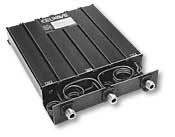| A loss of 1 dB is considered
acceptable. Higher dB losses will adversely affect the talk back
range of mobiles and in particular, handheld radios. A variation
of a duplexer, known as a combiner allows multiple transmitters to
use one antenna and multiple receivers to use another. Combiners
are commonly used with trunking systems and/or on commercial rental
towers. The losses can be significant (3 dB or more is not
uncommon). High power (over 50 watts) typically results in a
higher priced duplexer, often with higher loss. You can learn more
about duplexers by clicking here.
For now, we will simply say that obtaining an FCC frequency assignment
for optimally separated frequencies, keeping power to 50 watts or less,
and selection of the proper duplexer is a major consideration in system
planning.
Tower height is another important
consideration. Your greatest benefit generally comes with the
first 50 feet (typically a 3 dB improvement over ground level).
100 feet will provide approximately a 5 dB improvement. 200 feet
results in approximately a 6 dB improvement, 300 feet around 8 dB and
500 feet, a little more than 9 dB. This is an expensive way to
improve system performance. The better alternative, at least in our opinion
would be the use of multiple repeater stations, less powerful
transmitters, and smaller towers designed to provide coverage into
specific overlapping areas. For additional information on other
elements of repeater station planning, click here.
|
